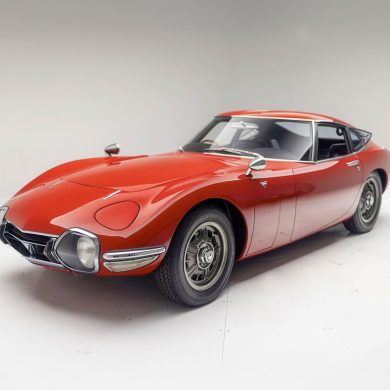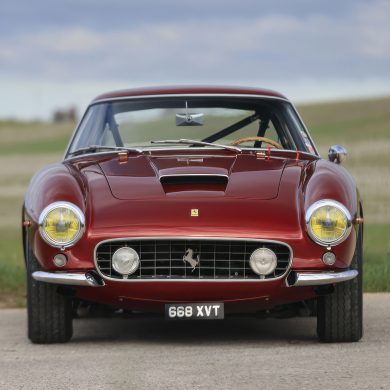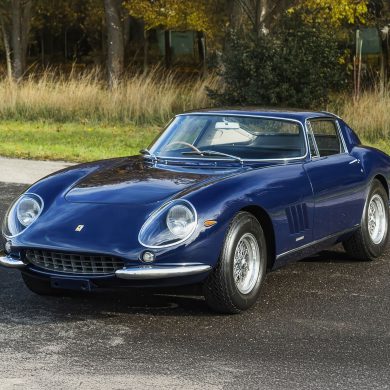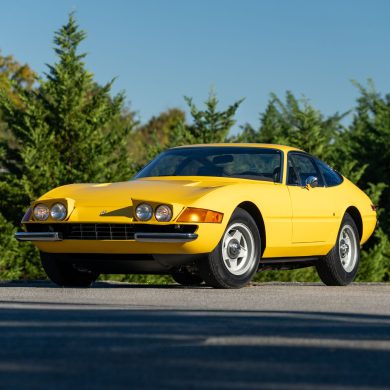The 1913 5-litre Bugatti Type 18 Sports Two-Seater known as “Black Bess” and widely regarded as the most important Type 18 in existence will star in Bonhams’ 
With continuous history from new, this Bugatti has the most extraordinary provenance and in 95 years has had just a handful of owners – featuring many distinguished names. This is the first time that “Black Bess” has come to auction and Bonhams anticipates interest from connoisseurs around the world. It is estimated to fetch €1,300,000 – 1,600,000.
One of only three surviving examples of just seven Type 18s built, “Black Bess” is widely regarded as the most desirable example available. One is entombed in the Schlumpf Collection (French National Motor Museum) and the other is privately owned in the UK. “Black Bess” is very original, retaining its original chassis, engine and body. It is also chain drive which is most desirable on a motor car of this period.
This car was delivered new to the pioneer French aviator Roland Garros, the first aviator to fly the Mediterranean. In 1913 he had been invited by Ettore Bugatti to the factory at Molsheim and, impressed by the Type 18, ordered a chassis – number 474 – with a sporting two-seater body by notable French coachbuilder Labourdette. To check on its progress, Garros would regularly fly down to Molsheim in the airplane, a Morane-Saulnier that he had used on his epic trans-Mediterranean flight.
When hostilities commenced in 1914 Garros joined the flying corps and is believed to have driven to a flying meeting in Vienna in the Bugatti. Although he survived being shot down in 1915, he was killed three weeks before the Armistice when he was shot down again. Ettore Bugatti, who had become a close friend, named his last child – born in 1922 – ‘Roland’ in honor of Garros.
His Bugatti was acquired by another pilot, Audemars, who passed it on to Louis Coatalen, Chief Engineer of the Sunbeam Motor Company Ltd in Wolverhampton. Coatalan was responsible for the war-time Sunbeam aero-engines, and he used the fast and reliable 5-litre car on his regular trips between London and Paris.
After the war, the 1913 Bugatti was bought by Miss Ivy Cummings. Introduced to competitive motor sport by her father, she successfully competed in many speed hill-climbs and speed-trials in the car between 1919 and 1924. She named the Bugatti “Black Bess” after Dick Turpin’s legendary steed, and this affectionate title has stayed with the car ever since.
Ivy Cummings became a well-known figure in “Black Bess” at sprint events in the early ’20s and she was reported as ‘handling it with skilful abandon’ at one of her favorite venues, ‘Kop Hill’ near Princes Risborough. This was no mean feat in a 4-cylinder 5-litre Bugatti capable of a top speed of 100mph.
Ivy Cummings competing in “Black Bess” in 1923 at Kop Hill. © Aries Press
In 1925, after the RAC had banned public road speed trials, Cummings sold the Bugatti to an Oxford undergraduate, a Mr Preston, who raced it the same year at Brooklands. It is also thought to have been driven by the late Sammy Davis while in Preston’s ownership. The car then passed into the hands of a young actor, James Robertson Justice, who planned to compete in it himself. He discovered, however, that a considerable amount of work was needed, and “Black Bess “was taken to McEvoys in Derby.
It was here that Bill Boddy, a journalist for Motor Sport, the magazine he later edited for 45 years, tracked down “Black Bess” in 1933. The car was bought by Col. G M Giles, Vice President of the Bugatti Owners’ Club, who restored it to its former glory. He paraded “Black Bess” at the opening rally of the club’s new hill-climb course at Prescott and went on to compete in the car at other events with his brother. With the approach of war in 1938, Col. Giles was not able to use his Bugatti and he sold it to Rodney Clarke for £200 with a spare engine and second chassis (that was to be later built and become the ‘third’ surviving Type 18).
Records of ‘Black Bess’s motor sport successes are next seen after the war, driven by Clarke, who kept it until ill health caused him to search out someone else who would appreciate how special the car was. Thus, in 1948, “Black Bess” entered the stable of the late Peter Hampton, a true Bugatti aficionado who already had a remarkable collection of early Bugattis.
Within two weeks of buying the car, Hampton gamely undertook an epic drive to the 1948 French Grand Prix at Reims, with “Black Bess” performing faultlessly. Nevertheless, being a perfectionist, he decided to carry out a second complete overhaul. As one of Hampton’s prized possessions for 40 years, “Black Bess” was seen at innumerable club events.
In 1988 Hampton sold the car to the current owner, a fellow Bugatti enthusiast and connoisseur of historic racing cars. Over the last 20 years it has continued to be used for rallies and in competition, meticulously prepared by renowned Bugatti engineer Ivan Dutton. “Black Bess” retains the original Labourdette doorless body and so remains the same car today that Roland Garros took delivery of 95 years ago.
Driven competitively on road and track for almost a century – this is a remarkable story of a very special car.
[Source: Bonhams]










